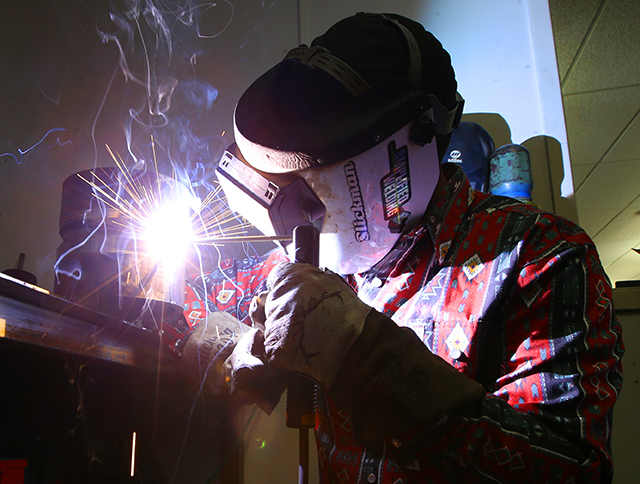New player enters the Broken Top saga
Published 5:00 am Thursday, May 24, 2007

- Golfer Linda Clark tees off at the Broken Top Club in 2002. The club's new owners want to develop part of the club's land. In return, they would cover the club's losses until the club turns profitable, according to a memo from a member of the club's new ownership group.
For years, the 250 or so members of Bend’s Broken Top Club have played on an exclusive, top-drawer golf course with plenty of elbow room, surrounded by quiet gated neighborhoods with some of the city’s most expensive homes.
Their dues haven’t come close to paying the bills. But the developers who have owned the club have picked up the tab, keeping the course green and the neighborhood happy with plenty of open space and few outsiders to populate it.
Those days may be coming to an end. One way or another.
In a memo to some of the club’s members earlier this month, which was widely distributed on Internet bulletin boards and e-mail lists, Tom Brenneke, a Portland-based member of the club’s new ownership group, essentially outlined a two-pronged choice for the members: Let the owners develop part of the club with up to 500 hotel, condo and townhome units, or be ready to pay higher dues to cover the costs.
Possibly, much higher. The club lost $1.3 million in 2006, according to Brenneke’s memo, ”and is projected to lose close to that in 2007.”
Brenneke is the president and CEO of Portland-based Guardian Management LLC, a multistate manager and developer of multifamily buildings.
In an e-mailed response to questions from The Bulletin on Wednesday, he said he is the manager of Broken Top Management LLC, which manages Broken Top Partners LLC, the club’s ownership entity.
Broken Top Partners LLC, in turn, was sold in January to a trust set up to benefit two teenage girls.
Brenneke’s e-mail said he is ”a decision-maker with full authority” over the club’s affairs, but it’s still not clear exactly what connection he has to the trust or its beneficiaries.
Whatever the case with the trust, Brenneke said he is moving quickly to get his plans in front of the club’s members, as well as the Broken Top Community Association, which represents the 634 homes that surround the club’s golf course.
Meanwhile, a group of club members is continuing to work on proposals for a membership buyout, which might be ready next month, club advisory board member Mel Stoltz said.
And a group of members who filed a legal action earlier this year to uphold a membership buyout plan pitched last year by former owner Don Bauhofer has threatened to turn the legal action into a full-blown lawsuit if Brenneke’s ownership group fails to respond to requests for mediation by Friday night.
Where everything will land – with a new development, with a member-owned club, with a club with much higher membership fees, or possibly with a bankruptcy – is still up in the air. Still, Brenneke’s latest memo, and his apparent willingness to make a concrete proposal, seems to be sparking some optimism that the club on the city’s far west side will soon be able to determine its future.
Brenneke has accepted an invitation to pitch his plans to the community association at a specially called homeowners meeting June 8, BTCA President Ron Webber said. There also are plans in the works for him to meet with the club’s members again early next month, Stoltz said.
”We are hoping the result of these meetings will be that we will get something more clear-cut and definitive,” Webber said. ”But the whole control over that is in the hands of the owner.”
Stoltz agreed.
”I think those meetings will pretty much decide which way all of this is going to go,” he said Tuesday.
Redevelopment
What Brenneke’s group wants is clearly outlined in his memo – the right to develop at least some of the club’s land.
If redevelopment goes forward, the ownership group would agree to continue to cover the club’s losses until it turns profitable, while sinking $15 million to $20 million into new facilities just for the club’s members, including new locker rooms, a member’s dining area, a lounge and pro shop – all built into the hotel building – along with a separate community center with a fitness club, a children’s activity area, a rock climbing wall, indoor and outdoor pools, concierge services and access to the hotel spa.
In exchange, the ownership group wants to build a 100-unit hotel-condo complex to be run by a ”five star luxury” hotel operator, according to the memo, along with up to 400 new townhomes and condos in ”a village at the center of Broken Top where the lake and existing club are located … similar in density to the resorts at Whistler, Northstar and Squaw Creek.”
Hotel guests would be limited to one tee time per hour.
Current Broken Top residents – most of whom are not club members – would get initiation-free sign-up rights to encourage more neighborhood memberships, according to the memo.
The group no longer plans to fill in the club’s centerpiece lake, Brenneke’s memo said.
With advice from Troon Golf, the worldwide golf course operator they brought in to run the course and the clubhouse in January, the ownership group figures that about 25 percent of their new condo, townhome, and hotel room buyers will buy club memberships, stabilizing the club with a profitable income stream, Brenneke’s memo said.
Brenneke promised to hold focus groups early this summer to clarify ideas he characterized as ”just that, thoughts.”
Under other alternatives, his memo said, the business situation looks bleak.
Bauhofer’s plan gave the members up to 10 years to find 300 ”equity members” willing to post up to $55,000 apiece to buy the club outright. In the meantime, he committed the club’s ownership entity – Broken Top Partners LLC, which he sold to the trust – to cover the club’s operating losses.
The legal action filed earlier this year by two of the equity members claims that Bauhofer’s program is binding on the new ownership group as well, because they bought the Broken Top Partners with all of its obligations. But, Brenneke’s memo said, the proposal brought in no new members, and it did not raise enough of the capital ”the club needs to be a sustainable first-class operation.”
By Troon’s estimation, the club would need at least 350 equity members – not 300 – to break even. To date, according to Bauhofer’s prior reports, it has about 145.
Trying to sell ownership memberships in a club that is sustaining $1.3 million a year in losses that may need to be covered by rising assessments makes memberships harder to sell, not easier, Brenneke’s memo argued.
Darker possibilities
In a follow-up e-mail to The Bulletin, he hinted that darker possibilities might be in store if his group is forced to carry the losses with no hope of development.
”The club has suffered and continues to suffer operating losses in excess of $1 million per year,” Brenneke’s e-mail said. ”While we work toward a solution with club members and homeowners, ownership is committed to funding the operating losses. It is critical that we arrive at a mutually agreeable solution in a timely way in order to prevent the threat of bankruptcy.”
His memo to the members promised that the ownership group will consider a competing proposal floated by some club members to drum up more membership from the surrounding Broken Top neighborhoods, where most residents don’t own either golf memberships or social memberships to the club.
But, failing to get a development project or some other plan to boost membership, ”we will have no choice but to raise dues to cover the losses” and continue with Bauhofer’s plan, the memo said.
If a redevelopment plan is approved, the club’s current membership would be dissolved, according to the memo. Current members would have the right to trade their existing memberships for memberships in the new club, and any equity payments made by club members under Bauhofer’s plan would be refunded.
Getting a significant redevelopment plan approved on the club’s land will likely require an extensive process at City Hall. The club’s land is all zoned for single-family homes, which would technically allow about seven units per acre, according to the city’s general development codes. But the Broken Top subdivision, including the golf course, is governed by a master plan created in the early 1990s that dictates where development can go in the neighborhood, and how much of it there can be.
Changing the master plan would likely require a large measure of cooperation from the community association and other nearby neighborhoods.






